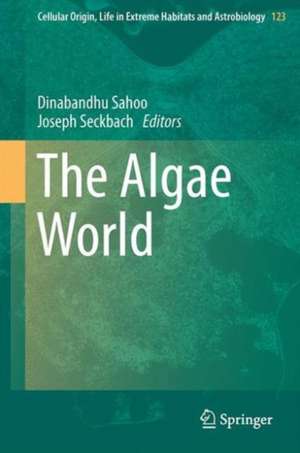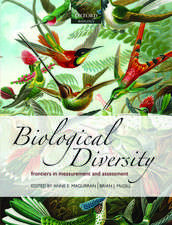The Algae World: Cellular Origin, Life in Extreme Habitats and Astrobiology, cartea 26
Editat de Dinabandhu Sahoo, Joseph Seckbachen Limba Engleză Hardback – 29 dec 2015
| Toate formatele și edițiile | Preț | Express |
|---|---|---|
| Paperback (1) | 1313.17 lei 38-45 zile | |
| SPRINGER NETHERLANDS – 14 mar 2019 | 1313.17 lei 38-45 zile | |
| Hardback (1) | 1683.66 lei 3-5 săpt. | |
| SPRINGER NETHERLANDS – 29 dec 2015 | 1683.66 lei 3-5 săpt. |
Din seria Cellular Origin, Life in Extreme Habitats and Astrobiology
- 5%
 Preț: 1440.04 lei
Preț: 1440.04 lei - 18%
 Preț: 1839.32 lei
Preț: 1839.32 lei - 18%
 Preț: 1848.33 lei
Preț: 1848.33 lei - 18%
 Preț: 1839.32 lei
Preț: 1839.32 lei - 18%
 Preț: 1222.27 lei
Preț: 1222.27 lei - 18%
 Preț: 1232.26 lei
Preț: 1232.26 lei - 18%
 Preț: 2098.03 lei
Preț: 2098.03 lei - 18%
 Preț: 1228.29 lei
Preț: 1228.29 lei - 18%
 Preț: 2111.46 lei
Preț: 2111.46 lei - 24%
 Preț: 1076.36 lei
Preț: 1076.36 lei - 18%
 Preț: 1828.11 lei
Preț: 1828.11 lei - 18%
 Preț: 951.14 lei
Preț: 951.14 lei - 18%
 Preț: 1219.94 lei
Preț: 1219.94 lei - 18%
 Preț: 1235.08 lei
Preț: 1235.08 lei - 18%
 Preț: 1252.76 lei
Preț: 1252.76 lei - 18%
 Preț: 1263.01 lei
Preț: 1263.01 lei - 18%
 Preț: 956.50 lei
Preț: 956.50 lei - 18%
 Preț: 956.03 lei
Preț: 956.03 lei - 18%
 Preț: 1234.46 lei
Preț: 1234.46 lei - 18%
 Preț: 1122.58 lei
Preț: 1122.58 lei - 15%
 Preț: 646.11 lei
Preț: 646.11 lei - 18%
 Preț: 1840.91 lei
Preț: 1840.91 lei - 18%
 Preț: 1231.16 lei
Preț: 1231.16 lei - 18%
 Preț: 1251.50 lei
Preț: 1251.50 lei - 18%
 Preț: 961.41 lei
Preț: 961.41 lei
Preț: 1683.66 lei
Preț vechi: 2053.25 lei
-18% Nou
Puncte Express: 2525
Preț estimativ în valută:
322.16€ • 336.37$ • 266.63£
322.16€ • 336.37$ • 266.63£
Carte disponibilă
Livrare economică 14-28 martie
Preluare comenzi: 021 569.72.76
Specificații
ISBN-13: 9789401773201
ISBN-10: 9401773203
Pagini: 450
Ilustrații: XII, 598 p. 254 illus., 149 illus. in color.
Dimensiuni: 155 x 235 x 38 mm
Greutate: 1.32 kg
Ediția:1st ed. 2015
Editura: SPRINGER NETHERLANDS
Colecția Springer
Seria Cellular Origin, Life in Extreme Habitats and Astrobiology
Locul publicării:Dordrecht, Netherlands
ISBN-10: 9401773203
Pagini: 450
Ilustrații: XII, 598 p. 254 illus., 149 illus. in color.
Dimensiuni: 155 x 235 x 38 mm
Greutate: 1.32 kg
Ediția:1st ed. 2015
Editura: SPRINGER NETHERLANDS
Colecția Springer
Seria Cellular Origin, Life in Extreme Habitats and Astrobiology
Locul publicării:Dordrecht, Netherlands
Public țintă
ResearchCuprins
Preface.- List of Authors and their addresses.- PART 1. Biology of Algae.- 1. General characteristics of Algae.- 2. Classification of Algae.- 3. Cyanobacteria.- 4. Green algae.- 5. Growth forms and life histories in green algae.- 6. Brown algae.- 7. Red algae.- 8. Diatoms: Yellow or Golden Brown Algae.- 9. Xanthophyceae, Euglenophyceae and Dinophyceae.- 10. Survey Of Algae In Extreme Environments.- PART 2. Applied Phycology.- 11. Algal Biotechnology.- 12. Harmful Algal Blooms.- 13. Phycoremediation.- 14. Bioactivity of secondary metabolites from Macroalgae.- 15. Marine algae: Gathered resource to global food industry.- 16. Metalic Nanoparticle Synthesis by Cyanobacteria: Fundamentals and Applications.- 17. Blue Green Algae: A Potential Biofertilizer For Rice.- 18. Polyunsaturated Fatty Acids From Algae.- 19. Algae as a source of biofuel.- 20. Phylogenomics in Algal Research: Current Trends and Future Perspectives.- 21. Advance Techniques in Algae.- 22. Culturing Micro Algae.
Notă biografică
Prof. Dinabandhu Sahoo is a full professor at the Department of Botany, University of Delhi, Delhi 110007, India. He obtained his M. Sc. and Ph.D. degrees from University of Delhi. He has been actively engaged in research and teaching in the field of Algae since 1983. His major research interests include Algal Biofuel and Carbon dioxide capture, Seaweeds Biology, their cultivation and utilization. He was the First Indian student to visit Antarctica during 1987-88 in the 7th Indian Scientific Expedition to Antarctica and was part of the team which laid the Foundation for “MAITRI” India’s permanent Scientific station in Antarctica. Subsequently he undertook two trips to Arctic during 1991 and 1992. He has visited all the seven continents and five oceans within a record time of 18 months during 1987-89. He was a visiting fellow at Smithsonian Institution, Washington DC, USA; INSA –JSPS visiting fellow at USA Marine Biology laboratory, Japan; visiting fellow at University of Connecticut, Stamford, USA and traveled extensively to many parts of the world. As the Convener, he organized an International Conference on Applied Phycology entitled “Algae in Biotechnology and Environment" in 2006, 7th Asia Pacific Conference on Algal Biotechnology in 2009 and International Algal Summit in 2012 at New Delhi, India. He has been a Member of the Working Group of Asian Network for using Algae as CO2
sink, Council member of Asia –Pacific Society for Applied Phycology and Secretary of Indian Phycological Society. Prof. Sahoo is recipient of several awards including Young Scientist Award.He received the highest award from National Environmental Science Academy, India in 2009 for his outstanding contribution in the field of Marine Science. He has been featured amongst India’s twenty social entrepreneur in the best selling book “I have a Dream” which is now being translated into several Indian Languages He has published a number of research papers and books on algae and related fields. Professor Joseph Seckbach has been the founder and chief editor of Cellular Origins, Life in Extreme Habitats and Astrobiology (“COLE”) with ~30 books in that series. He has co-edited other volumes, such as the Proceeding of Endocytobiology VII Conference (Freiburg, Germany) and the Proceedings of Algae and Extreme Environments meeting (Trebon, Czech Republic). See http://www.schweizerbart.de/pubs/books/bo/novahedwig-051012300-desc.ht). His edited the recent volume (with Richard Gordon) entitled Divine Action and Natural Selection: Science, Faith, and Evolution published by World Scientific Publishing Company. He is currently still busy with new books publications and new chapters. Dr. Seckbach earned
his Ph.D. from the University of Chicago (1965) and did a post doctorate in the Division of Biology at Caltech, in Pasadena, CA. He headed a group at UCLA studying the life possibilities on Venus, later he was appointed to the Hebrew University, Jerusalem and spent sabbaticals at UCLA and Harvard University. Dr. Seckbach enjoyed his DAAD-sponsored (The German Academic Exchange) periods in Tübingen, Germany, and at LMU, Munich. He served at Louisiana State University (LSU), Baton Rouge, LA, USA, as the first selected Chair for the Louisiana Sea Grant and Technology transfer. Beyond editing academic volumes, he has published ~ 140 scientific articles on plant ferritin–phytoferritin, cellular evolution, acidothermophilic algae, life in extreme environments and on Astrobio-logy. He also edited and translated several popular books. Dr. Seckbach is the co-author, with R. Ikan, of the Hebrew-language Chemistry Lexicon (two editions by Deveer publisher, Tel-Aviv). His recent interest is in the field of enigmatic microorganisms as the life in extreme environments and Astrobiology. He enjoys visiting many Universities and Institutes and presenting there seminars on his studies.
sink, Council member of Asia –Pacific Society for Applied Phycology and Secretary of Indian Phycological Society. Prof. Sahoo is recipient of several awards including Young Scientist Award.He received the highest award from National Environmental Science Academy, India in 2009 for his outstanding contribution in the field of Marine Science. He has been featured amongst India’s twenty social entrepreneur in the best selling book “I have a Dream” which is now being translated into several Indian Languages He has published a number of research papers and books on algae and related fields. Professor Joseph Seckbach has been the founder and chief editor of Cellular Origins, Life in Extreme Habitats and Astrobiology (“COLE”) with ~30 books in that series. He has co-edited other volumes, such as the Proceeding of Endocytobiology VII Conference (Freiburg, Germany) and the Proceedings of Algae and Extreme Environments meeting (Trebon, Czech Republic). See http://www.schweizerbart.de/pubs/books/bo/novahedwig-051012300-desc.ht). His edited the recent volume (with Richard Gordon) entitled Divine Action and Natural Selection: Science, Faith, and Evolution published by World Scientific Publishing Company. He is currently still busy with new books publications and new chapters. Dr. Seckbach earned
his Ph.D. from the University of Chicago (1965) and did a post doctorate in the Division of Biology at Caltech, in Pasadena, CA. He headed a group at UCLA studying the life possibilities on Venus, later he was appointed to the Hebrew University, Jerusalem and spent sabbaticals at UCLA and Harvard University. Dr. Seckbach enjoyed his DAAD-sponsored (The German Academic Exchange) periods in Tübingen, Germany, and at LMU, Munich. He served at Louisiana State University (LSU), Baton Rouge, LA, USA, as the first selected Chair for the Louisiana Sea Grant and Technology transfer. Beyond editing academic volumes, he has published ~ 140 scientific articles on plant ferritin–phytoferritin, cellular evolution, acidothermophilic algae, life in extreme environments and on Astrobio-logy. He also edited and translated several popular books. Dr. Seckbach is the co-author, with R. Ikan, of the Hebrew-language Chemistry Lexicon (two editions by Deveer publisher, Tel-Aviv). His recent interest is in the field of enigmatic microorganisms as the life in extreme environments and Astrobiology. He enjoys visiting many Universities and Institutes and presenting there seminars on his studies.
Textul de pe ultima copertă
Algae are an important group of organisms which are found in a wide range of habitats be it oceans, rivers, fresh water lakes, ponds or brackish water bodies, snow, barks of the trees, etc. Ranging from a small tiny cell to the Giant Kelp measuring up to several metres, this group of plants have some unique features which are not found in any other group of organisms. Algae have both Prokaryotic and Eukaryotic groups, large varieties of pigment systems, triphasic life cycle and a long evolutionary history. Algae have also changed the planet’s atmosphere by producing oxygen thus paving the way for evolution of life on earth. These tiny organisms not only give us oxygen to breathe, food to eat, medicines to heal and cosmetics to use but they also provide a lot of information about the origin of life. It has been predicted that not only vehicles will run on algal biofuels in the future but power plants will use algae for carbon dioxide sequestration. Despite its huge importance, algae remains a much neglected subject because of its stereotype boring class room table materials as “Pond Scum”. Globally, algae is already a multi-billion dollar industry employing large numbers of people in various industries and their value is set to increase in future. Therefore, the purpose of writing and editing this book is not to publish one more text book in the field of phycology but to give an alternative outlook and encouragementto our readers and students to understand, feel and unravel the beauty and use of this group of organisms in many different ways. The 22 chapters are divided into two different parts which have been authored by eminent researchers from across the world. The first part, Biology of Algae, contains 10 chapters dealing with the general characteristics, classification and description of different groups such as Blue Green Algae, Green Algae, Brown Algae, Red Algae, Diatoms, Xanthophyceae, Dinophyceae, etc. In addition, it has two important chapters covering Algae in Extreme Environments and Life Histories and Growth Forms in Green Algae. The second part, Applied Phycology, contains 12 chapters dealing with the more applied aspects ranging from Algal Biotechnology, Biofuel, Phycoremediation, Bioactive Compounds, Biofertilizer, Fatty Acids, Harmful Algal Blooms, Industrial Applications of Seaweeds, Nanotechnology, Phylogenomics and Algal culture Techniques, etc. This volume has been carefully written and edited with an interdisciplinary appeal and aims to bring all aspects of Algae together in one volume.
Caracteristici
This volume has been carefully written and edited with an interdisciplinary appeal and aims to bring all aspects of Algae together in one volume Containing 22 chapters authored by eminent researchers from across the World Provides an alternative outlook and encouragement to readers and students on the beauty and use of Algae















